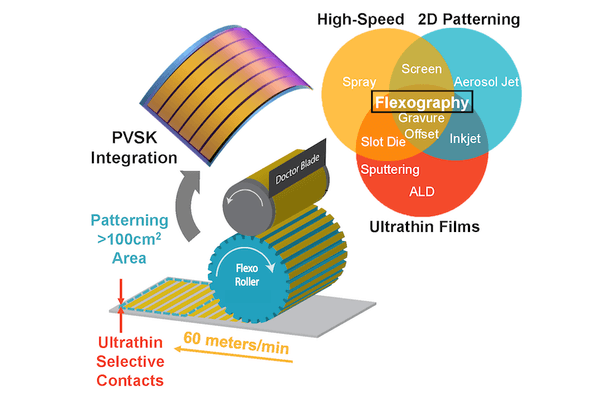- Undergraduate
Bachelor's Degrees
Bachelor of ArtsBachelor of EngineeringDual-Degree ProgramUndergraduate AdmissionsUndergraduate Experience
- Graduate
Graduate Experience
- Research
- Entrepreneurship
- Community
- About
-
Search
All Thayer News

Dartmouth Engineers Develop Rapid Printing Method for More Affordable Solar Technology
Jan 13, 2022 | by Julie Bonette
A group of Dartmouth engineers has developed the quickest reliable printing method for the manufacturing of perovskite solar cells, which can be used to efficiently harness and convert solar energy. The method may help scale the use of efficient solar technology, such as electric vehicles.
Though metal halide perovskites are the most promising new abundant absorber material to increase global solar capacity, it is difficult to scale due to slow production time, yielding high manufacturing costs. However, a Dartmouth Engineering lab has developed a method that accelerates total processing time of solar charge transport layers (CTLs) by 60 times while maintaining reliability.
"Our method prints the layers of the solar cell with the speed and efficiency of a commercial newspaper printing press. This high manufacturing speed is important because it directly translates to lower cost per kWh, which will ultimately make solar energy more affordable for a larger population."
Dartmouth Engineering Professor William Scheideler

The flexography method for high speed printing of lightweight perovskite solar cells. The accompanying Venn diagram shows technological benefits for manufacturing the charge transport layers critical in perovskite solar modules.
The study, "Eliminating the Perovskite Solar Cell Manufacturing Bottleneck via High-Speed Flexography," was recently published in Advanced Materials Technologies and authored by engineering PhD candidate Julia Huddy, research associate Youxiong Ye, and Scheideler.
The researchers' method involves pairing high-speed flexographic printing with rapidly annealed sol-gel inks. When compared to silicon photovoltaic production, the Dartmouth method is faster and also more efficient in terms of energy usage and required materials.
"An advantage of our process is that it can be used to print solar cell layers on flexible or rigid substrates, allowing for applications of solar energy that go beyond typical silicon solar panels," said Huddy.
"The impact of solar energy and its penetration into the electrical grid depend critically on the cost of manufacturing solar cells. This is where innovation in the lab is still needed to accelerate the potential of renewable technologies," said Scheideler.
For contacts and other media information visit our Media Resources page.
